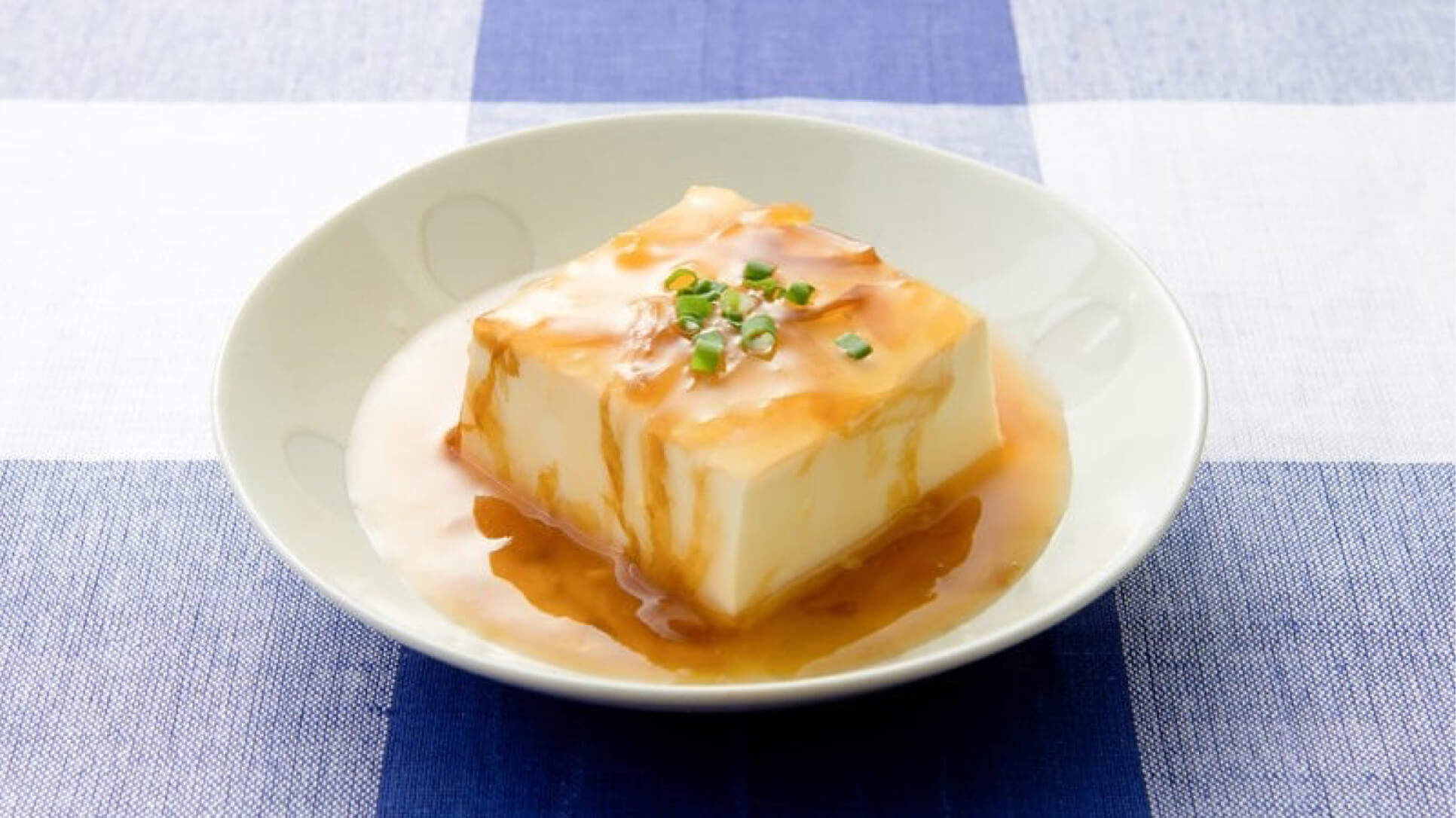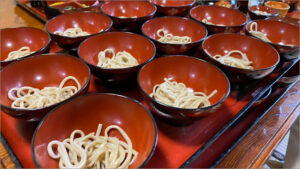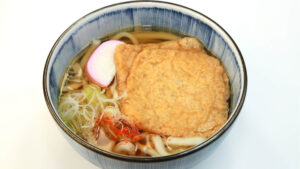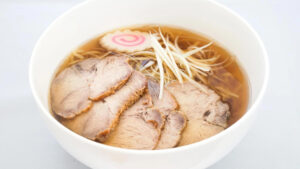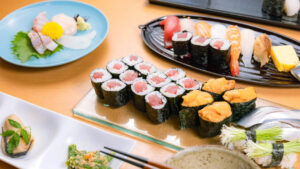Tofu, a staple ingredient long beloved in Japanese households, is simple yet highly nutritious—and it’s now gaining worldwide attention among health-conscious eaters. Low in calories and rich in protein, tofu is also incredibly versatile, making it suitable for vegan and gluten-free diets.
This article introduces the appeal of tofu and its basic varieties, along with easy-to-make home recipes, creative main dishes, and even desserts—all using tofu, the heart of many Japanese meals.
Whether you’re new to tofu or hoping to recreate the authentic taste of Japanese cuisine, this guide will help you enjoy delicious and healthy tofu dishes in your own kitchen!
Contents
- 1 Discover the Appeal and Varieties of Tofu
- 2 Easy and Delicious: 3 Classic Tofu Recipes You Can Make at Home
- 3 Hearty Tofu Recipes That Can Be the Main Dish
- 4 Tofu Transformed into Dessert: Sweet Tofu Treats
- 5 Tips & Ideas for Enjoying Tofu Abroad
- 6 Tofu: Japan’s Versatile Superfood Loved Around the World
Discover the Appeal and Varieties of Tofu
Why Tofu Is Loved in Japanese Cuisine
A Healthy Food—High in Protein, Low in Calories
Tofu is a non-fermented food made from soybeans, rich in plant-based protein. With its very low calorie content, it’s an ideal ingredient for health-conscious diets and those aiming to lose weight. Tofu is often used as a substitute for meat or fish in main dishes, offering nutrition without straining the body. In Japan, it has long been a key ingredient in “shojin ryori” (Buddhist vegetarian cuisine) and other traditional dishes.
Perfect for Vegans and Vegetarians
For those following a vegan or vegetarian lifestyle, tofu is an incredibly reliable option. Not only can it substitute for cheese or meat in a wide range of recipes, but its mild flavor and aroma pair well with virtually any seasoning. Around the world, more and more vegan recipes are incorporating tofu as a versatile and satisfying ingredient. Traditional Japanese tofu dishes, many of which are entirely plant-based, offer deep, umami-rich flavors that are now being appreciated globally.
A Simple Base That Enhances Other Flavors
Tofu has a naturally subtle taste, making it an ideal partner for Japanese seasonings such as dashi, soy sauce, and sesame oil. Whether served chilled as “hiyayakko,” deep-fried in broth as “agedashi tofu,” or stir-fried and added to hot pots, tofu adapts to many cooking styles. In Japanese cuisine, which emphasizes drawing out the natural flavors of ingredients, tofu stands out as a symbol of simplicity and depth.
Types of Tofu and Their Characteristics
Japanese tofu comes in a variety of types, each with different textures, moisture levels, and ideal cooking methods. By understanding these differences, you can choose the right tofu for the right dish—and enjoy it even more deliciously.
Silken Tofu (Kinu-goshi)
Silken tofu contains a high amount of water and has a smooth, creamy texture that almost melts in your mouth. It’s made by pouring the tofu mixture directly into molds and setting it as-is, resulting in a soft, delicate block with a glossy surface. This type is perfect for chilled dishes like hiyayakko, soups, or even desserts. It can be enjoyed as-is with a spoon, and because of its mild flavor, it pairs easily with various toppings such as ponzu, sesame sauce, or even olive oil for a modern twist.
Firm Tofu (Momen)
Firm tofu is made by pressing the tofu curds in cloth to remove excess water before shaping, giving it a denser and sturdier texture compared to silken tofu. It’s slightly higher in protein and calcium and holds its shape well during cooking, making it ideal for stir-fries, deep-fried dishes, or grilled recipes. Because it doesn’t easily fall apart, it’s a popular choice for hearty meals like mapo tofu and tofu steaks.
Tips for Storing and Handling Tofu
Tofu is a delicate ingredient, and treating it properly is key to enjoying it both safely and deliciously. In this section, we’ll cover the best practices for storage and preparation.
Refrigerating and Freezing Tofu
Tofu should generally be stored in the refrigerator, and ideally used on the same day it’s opened. If you need to store it longer, place the tofu in a container filled with fresh water and refrigerate it. Replace the water daily, and it can last for 2 to 3 days.
Interestingly, tofu can also be frozen. When frozen, its texture changes significantly—it becomes more sponge-like as the moisture is drawn out. This texture makes it ideal for stir-fries or simmered dishes. In fact, frozen tofu—known in Japan as shimi-dofu—has been used in traditional recipes for generations.
How and Why to Drain Tofu
Before cooking, it’s common to drain tofu to remove excess moisture. Both silken and firm tofu contain a lot of water, and using them as-is can dilute the flavor of your dish or make it watery.
Draining tofu is simple: wrap the tofu in paper towels, place a plate or other light weight on top, and let it sit for 10–20 minutes. Alternatively, you can microwave it briefly to help release the moisture. Properly drained tofu absorbs flavors better and improves the overall texture of your dish.
Prepping Tofu Before Cooking
Since tofu is soft and can easily break apart, it’s important to handle it gently. When cutting, move the knife slowly and consider placing a damp cloth under your cutting board to prevent slipping. If you plan to stir-fry tofu, lightly sear it first to add a toasty flavor and help it keep its shape.
For simmered dishes, consider pre-soaking tofu in dashi broth to add depth of flavor. Because tofu itself is mild, even small steps in preparation can make a big difference in the final taste. A little care goes a long way in enhancing this simple but versatile ingredient.
Easy and Delicious: 3 Classic Tofu Recipes You Can Make at Home
Chilled Tofu (Hiyayakko)
Perfect for hot weather, hiyayakko is a refreshing and simple Japanese dish that requires no cooking at all. This minimalist recipe lets you enjoy the pure flavor and smooth texture of tofu at its best.
How to Make Basic Hiyayakko
All you need is silken tofu and a few simple toppings. Here’s how to make it:
- Take well-chilled silken tofu out of the fridge and remove it from the package. Gently blot off any excess moisture.
- Cut the tofu into serving-size pieces (about half a block per person) and place on a small dish.
- Drizzle with soy sauce and top with chopped green onions and bonito flakes. That’s it!
No heat, no fuss—ready in just 3 minutes. It’s ideal for busy days or when you’re feeling too hot or tired to cook.
Recommended Toppings
One of the joys of hiyayakko is the variety of toppings you can mix and match. Here are some popular options in Japan:
- Chopped green onions: Add a fresh aroma and a pop of color.
- Bonito flakes: Enhance flavor with a savory, umami-rich touch.
- Grated ginger: Adds a light spiciness to balance the mild tofu.
- Sesame seeds or sesame oil: Bring out a nutty richness.
- Pickled plum (umeboshi) or shiso leaves: Give it a tangy, aromatic twist.
You can combine these however you like to suit your mood and taste—no two hiyayakko dishes need to be the same!
Asian-Inspired Flavor Twists
Hiyayakko isn’t limited to just Japanese flavors. It can easily be adapted to fit other Asian cuisines as well:
- Fish sauce + lime + cilantro: A Southeast Asian-style tangy topping.
- Sweet chili sauce + crushed peanuts: A sweet and spicy combination that adds crunch.
- Gochujang + sesame oil + kimchi: A Korean-inspired spicy variation.
Thanks to tofu’s naturally mild flavor, hiyayakko pairs well with all kinds of spices and herbs. Whether Japanese, Western, or Asian-inspired, this dish offers endless versatility with just a few ingredients.
Mapo Tofu
Originally from Sichuan Province in China, Mapo Tofu has become a beloved dish in Japan as well. It’s widely enjoyed as a home-cooked meal, often adapted to suit local tastes. In Japan, a mild version with less spice is common so that even children can enjoy it—but there are also authentic Sichuan-style versions and vegan adaptations, offering a wide range of flavors.
Japanese-Style Mild Mapo Tofu
The Japanese version of Mapo Tofu is known for its gentle flavor and low level of spiciness. Here’s a typical way to prepare it:
- Sauté ground meat (usually pork or chicken) in a frying pan.
- Add minced green onions, ginger, and garlic to release their aroma.
- Season with soy sauce, miso, sugar, and sake, then add cubed tofu.
- Thicken the sauce with a cornstarch slurry and serve.
This style pairs perfectly with steamed white rice and is often called a “rice stealer” because of how addictive it is. It’s especially popular with kids and those who prefer less spicy food.
Authentic Sichuan-Style Mapo Tofu
The traditional Sichuan version is famous for its bold heat and signature numbing sensation. Two essential ingredients are Doubanjiang (chili bean paste) and Huajiao (Sichuan peppercorns). Key points for making this style include:
- Frying Doubanjiang, sweet bean paste (Tianmianjiang), and fermented black beans (Douchi) in oil to build depth of flavor.
- Adding ground Sichuan peppercorns for the unique numbing “mala” taste.
- Using silken tofu for a smooth, silky texture.
The result is a dish bursting with spicy aroma and umami, sure to please fans of bold flavors. It pairs wonderfully with white rice or even beer.
Vegan-Friendly Variation
Mapo Tofu can also be adapted into a vegan-friendly dish. By using only plant-based ingredients, you can still achieve a flavorful and satisfying result:
- Replace meat with crumbled soy protein (textured vegetable protein) or finely chopped mushrooms.
- Use dashi made from kombu (kelp) or shiitake mushrooms for depth.
- Season with miso and Doubanjiang, and thicken the sauce with cornstarch.
You can control the spice level or highlight natural umami, making it appealing even without animal products. The ingredients are easy to find globally, making this variation popular among those who prioritize environmental and health-conscious diets.
Tofu Miso Soup
Tofu miso soup is one of the most iconic staples of the Japanese breakfast and home-cooked meals. With its gentle flavor and well-balanced nutrition, it has also gained popularity among health-conscious people around the world. It’s quick and easy to make, and can be customized with different ingredients and types of miso.
The Classic Combo: Tofu and Wakame
One of the most classic and beloved versions of tofu miso soup includes wakame seaweed. This combination is perhaps the most common in Japan.
Silken tofu provides a smooth, delicate texture, while rehydrated wakame adds a satisfying, slightly chewy bite. A sprinkle of chopped green onion on top enhances the aroma, adds a pop of color, and makes the dish even more visually appealing.
Sample Ingredients (Serves 2):
Dashi (broth): 400 ml
Miso paste: 1 tablespoon
Tofu: approx. 100 g
Dried wakame: 1 teaspoon
Chopped green onion: to taste
Red Miso vs. White Miso
The flavor of your miso soup depends largely on the type of miso you use. In Japan, miso varies by region, but two common types are red miso and white miso.
- Red miso (Aka miso): Dark brown, fermented longer, with a deeper, saltier flavor. Popular in areas like Aichi and the Kansai region.
- White miso (Shiro miso): Light-colored, milder, and slightly sweet. Often used in Kyoto and western Japan.
Both types work well in tofu miso soup. Use white miso for a light and mellow finish, or red miso for a richer, more robust taste. Many people also enjoy mixing the two to create a balanced blend known as awase miso.
Making Great Dashi for Better Flavor
Dashi, the broth used in miso soup, is a key element of umami in Japanese cuisine. For simple ingredients like tofu, the quality of the dashi can make all the difference in taste.
Here are a few basic types of dashi:
- Kombu dashi: Made from kelp, it’s mild and plant-based—great for vegans.
- Katsuobushi dashi: Made from dried bonito flakes, it offers a rich and savory depth.
- Niboshi dashi: Made from dried sardines, with a bolder, fishier flavor often found in home-style cooking.
While instant dashi powders or tea bags are convenient substitutes, making your own dashi just once will reveal a dramatic improvement in the depth and authenticity of your miso soup.
Hearty Tofu Recipes That Can Be the Main Dish
Tofu Hamburger Steak
Tofu hamburger steak is a healthy, Japanese-style version of a classic meat patty, made by mixing ground meat with tofu. Compared to regular hamburgers, it’s lighter in calories and has a soft, fluffy texture. It’s a versatile recipe that can be seasoned and sauced in either Japanese or Western styles.
Basic Recipe and Prep
Ingredients (Serves 2):
- Firm tofu: 150g (well drained)
- Ground meat (beef & pork mix): 150g
- Onion: 1/2 (minced and sautéed, then cooled)
- Breadcrumbs: 2 tablespoons
- Egg: 1
- Salt & pepper: to taste
- Vegetable oil: as needed
Instructions:
- Wrap the tofu in paper towels and place a weight on top. Drain for 15–20 minutes.
- In a bowl, combine tofu, ground meat, sautéed onion, breadcrumbs, egg, salt, and pepper. Mix well.
- Shape into oval patties. Heat oil in a frying pan and cook both sides over medium heat. Cover with a lid and steam until fully cooked inside.
The tofu makes the patties surprisingly light and easy on the stomach—perfect for kids, the elderly, or anyone looking for a healthier alternative.
Refreshing with Grated Daikon Sauce
One popular way to enjoy tofu hamburger is with a refreshing Japanese-style sauce made from grated daikon radish and ponzu (citrus soy sauce). The light flavor complements the soft tofu perfectly.
Example Sauce:
- Grated daikon: 1/4 of a radish
- Ponzu: 2–3 tablespoons
- Optional toppings: shiso leaves, chopped green onion, yuzu kosho (citrus chili paste)
Pour the sauce generously over the freshly cooked patties. Even on days when you don’t have much appetite, this dish goes down smoothly and refreshingly.
Savory Teriyaki Style for Extra Flavor
If you’re in the mood for something heartier, try serving your tofu hamburger with teriyaki sauce. The sweet and savory glaze clings to the patty, turning it into a satisfying main dish that goes perfectly with rice.
Easy Teriyaki Sauce:
- Soy sauce: 1.5 tablespoons
- Mirin: 1.5 tablespoons
- Sugar: 1 teaspoon
- Sake: 1 tablespoon
After cooking the patties, wipe off excess oil in the pan and add the sauce ingredients. Let them simmer and reduce to a glossy glaze. The shine and rich flavor will boost both visual appeal and appetite!
Agedashi Tofu (Deep-Fried Tofu in Broth)
Agedashi tofu is a beloved Japanese home-style dish in which lightly coated tofu is deep-fried and served with a warm, flavorful broth. The outside is crispy and fragrant, while the inside stays soft and creamy. Elegant yet satisfying, it’s hearty enough to serve as a main dish.
Tips for Coating and Frying
Ingredients (Serves 2):
- Firm tofu: 1 block (approx. 300g)
- Potato starch (katakuriko): as needed
- Oil for frying: as needed
Frying tips:
- Thoroughly drain the tofu and pat the surface dry with paper towels to prevent crumbling and oil splatter.
- Cut into bite-sized cubes and coat evenly with potato starch.
- Deep-fry at medium heat (around 170°C / 340°F) for 2–3 minutes until the surface becomes crispy and lightly golden.
Potato starch gives the tofu a delicate crust and helps it absorb the broth beautifully. Once the surface is lightly browned, it’s ready.
Broth Made with Mentsuyu
The broth poured over the freshly fried tofu is often made with mentsuyu (concentrated noodle soup base), which makes it quick and easy to prepare. Here’s a simple ratio:
- Mentsuyu (3x concentrated): 3 tablespoons
- Water: 150 ml
- Mirin: 1 tablespoon
- Optional toppings: grated ginger, chopped green onion, grated daikon
Just warm all the ingredients in a pot, and it’s ready. Pour over the tofu to create a refined yet comforting dish full of umami and aroma. It’s a perfect example of understated Japanese elegance.
Seasonal Vegetable Add-Ons
Agedashi tofu can be beautifully enhanced with seasonal vegetables, making it even more colorful and flavorful. Here are some suggested pairings:
- Summer: Fried eggplant, bell peppers, or shishito peppers
- Autumn: Mushrooms such as enoki, shimeji, or shiitake simmered in the broth
- Winter: Grated daikon with a hint of yuzu zest for warmth and aroma
- Spring: Nanohana (rapeseed greens) or snap peas for a vibrant touch
By combining tofu with colorful seasonal vegetables, you can elevate the dish for both everyday meals and special occasions.
Tofu and Vegetable Stir-Fry
Tofu and vegetable stir-fry is a quick, well-balanced dish that’s both healthy and convenient. You can customize it with whatever vegetables you have on hand, and the flavor can easily shift between Japanese, Chinese, or Southeast Asian styles depending on the seasonings. Below are key tips and easy ideas to help you get started.
Proper Draining Prevents Crumbling
The most important tip for using tofu in stir-fries is proper draining. If tofu contains too much water, it will easily break apart during cooking and result in a soggy dish.
How to drain tofu:
- Wrap firm tofu in paper towels, place a flat plate or light weight on top, and let it sit for 15–20 minutes.
- If you’re short on time, wrap the tofu in paper towels and microwave for 1 minute (600W).
Well-drained tofu browns better and develops a fragrant crust, greatly enhancing the texture and overall flavor of your stir-fry.
Sesame Oil & Soy Sauce for a Classic Japanese Flavor
For a Japanese-style stir-fry, a simple combination of sesame oil and soy sauce works perfectly. It’s familiar to Japanese people and also approachable for international cooks looking to try “Japanese stir-fry” at home.
Basic seasoning (for 2 servings):
- Sesame oil: 1 tablespoon
- Soy sauce: 1 tablespoon
- Mirin: 1 teaspoon
- Optional: finish with toasted sesame seeds or ground sesame for added aroma
Recommended vegetables: bell peppers, carrots, onions, cabbage, bean sprouts, spinach
Simply stir-fry the tofu first, then add the vegetables and seasonings. Toss everything together briefly, and you’ll have a flavorful, rice-friendly main dish in minutes.
Spicy Variations to Boost Flavor
If you prefer bold flavors, try a spicy twist. Adding just a little heat can deepen the flavor and make the dish even more appetizing.
Ideas for spicy variations:
- Gochujang (Korean chili paste): 1 teaspoon for a sweet and spicy kick
- Doubanjiang (Chinese chili bean paste): for a Sichuan-style stir-fry
- Chili oil: a few drops at the end to add both aroma and heat
You can adjust the level of spiciness to your liking. Finding your perfect balance is part of the fun—and every version goes great with a bowl of white rice. It’s a satisfying main dish that’s easy to make and easy to love.
Tofu Transformed into Dessert: Sweet Tofu Treats
Tofu Pudding
Tofu pudding is a healthy dessert made without dairy or eggs. It features a smooth texture and gentle sweetness, and can be adapted to either Japanese or Western styles. Thanks to its simplicity and low-calorie profile, it’s a favorite for those on a diet or following a vegan lifestyle.
Easy No-Gelatin Recipe
One of the best things about tofu pudding is how easy it is to make. Just blend and chill—no gelatin or agar required. Silken tofu alone creates the smooth, pudding-like texture.
Ingredients (serves 2–3):
- Silken tofu: 300g (1 block)
- Maple syrup or honey: 2–3 tablespoons
- Vanilla extract: a few drops (optional)
Instructions:
- Lightly drain the tofu and place all ingredients in a blender.
- Blend until smooth and pour into small cups or bowls.
- Chill in the refrigerator for 1–2 hours before serving.
This dessert is simple, allergy-friendly, and perfect for health-conscious eaters.
Japanese Style: Kuromitsu & Kinako
For a traditional Japanese twist, try topping your tofu pudding with kuromitsu (black sugar syrup) and kinako (roasted soybean flour).
- The rich sweetness of kuromitsu enhances the delicate flavor of the tofu.
- Kinako adds a nutty aroma and a mochi-like Japanese confection feel.
Add toppings just before serving to keep the aroma and appearance fresh. It also pairs wonderfully with a cup of chilled green tea.
Western Style: Fresh Fruit & Sauce
To enjoy a more Western-style variation, add fresh fruits or fruit-based sauces.
- Great pairings: strawberries, blueberries, raspberries
- Add fruit sauce or jam for vibrant color and flavor
- Top with chopped nuts or mint leaves for a café-style look
Tofu pudding’s simplicity makes it easy to customize. Whether for everyday enjoyment or as an elegant treat for guests, it’s sure to please.
Tofu Cheesecake
Tofu cheesecake is a healthy dessert made by combining cream cheese and tofu. It’s lighter than traditional cheesecake, with reduced calories and fat—yet still delivers satisfying richness. Thanks to its mild flavor, it doesn’t carry the distinctive scent of tofu, making it a rising star in desserts around the world.
The Secret to a Moist and Silky Texture
What makes tofu cheesecake so appealing is its moist, creamy texture. The key lies in using silken tofu and blending the ingredients thoroughly.
- Silken tofu has high water content and blends smoothly with cream cheese.
- Using a blender or food processor ensures a fine, silky consistency.
- The light texture makes it an easy-to-eat dessert, even after a meal.
With mild sweetness and no tofu aftertaste, this dessert is enjoyable for both children and adults alike.
Baked and No-Bake Versions
Tofu cheesecake can be made in two styles: baked and no-bake. Both are simple and worth trying.
Baked Version:
- Mix tofu, cream cheese, eggs, sugar, and lemon juice.
- Pour into a mold and bake at 160–170°C (320–338°F) for 40–50 minutes.
- Cool thoroughly, then chill in the refrigerator before serving.
No-Bake Version:
- Blend all ingredients with added gelatin and chill to set.
- Optionally, make a simple crust using crackers or granola.
- Chill in the refrigerator for 3–4 hours until set.
The baked version has a roasted aroma, while the no-bake version offers a cool and refreshing taste. Choose based on your season or preference.
Gluten-Free Adaptations
As health awareness grows, gluten-free tofu cheesecake is also gaining popularity. With a few simple adjustments, it can be made without wheat flour:
- Use rice flour or almond flour instead of wheat flour in baked recipes.
- For the crust, use gluten-free biscuits or oats.
- No crust is needed for no-bake versions—just the filling will satisfy.
Tofu cheesecake’s flexibility makes it easy to adapt to dietary needs. For a vegan version, simply use plant-based cream cheese instead of dairy-based.
Tofu Ice Cream
Tofu ice cream is a healthy and creamy dessert that can be made without any dairy products. It takes advantage of tofu’s natural smoothness to create a light and refreshing treat you can enjoy without guilt. Perfect for those on a diet or following a vegan lifestyle.
Creamy Without Dairy
One of the biggest appeals of tofu ice cream is how creamy it can be—without using any dairy.
Basic Vanilla-Flavored Ingredients:
- Silken tofu: 1 block (approx. 300g)
- Maple syrup or agave syrup: 2–3 tablespoons
- Vanilla extract: a few drops
- Optional: a small amount of plant-based milk (soy milk or almond milk) for a smoother texture
How to Make:
- Blend all ingredients in a mixer until completely smooth.
- Transfer to a container and freeze. Stir every 1–2 hours to maintain a smooth texture.
Even without dairy fat, it turns out surprisingly creamy. The tofu flavor is very subtle—so subtle that even those who dislike tofu may not notice it at all.
Japanese-Inspired Flavors: Matcha, Kinako & More
Tofu ice cream can be flavored in countless ways. Japanese-inspired flavors are especially recommended:
- Matcha (green tea powder): Fragrant and slightly bitter, perfect for adult palates.
- Kinako & Kuromitsu (roasted soybean flour and brown sugar syrup): A balanced combo of nutty and sweet.
- Yuzu or Sudachi zest: Adds a refreshing citrus note, ideal for summer.
- Red bean paste or mochi toppings: Create a parfait-style Japanese dessert experience.
Freezing & Best Time to Eat
For the best experience, proper freezing and timing are key:
- Freshly made tofu ice cream will have a soft, soft-serve-like texture.
- If frozen for a long time, it can become hard—leave it at room temperature for about 20 minutes before serving to soften.
- Store in an airtight container and consume within 2–3 days for the best flavor.
- To avoid repeated thawing and refreezing, store in small portions.
Tofu ice cream is easy, healthy, and customizable—perfect for enjoying year-round.
Tips & Ideas for Enjoying Tofu Abroad
How to Buy and Choose Tofu
Tofu is widely available in many countries and can often be found more easily than expected. However, the variety might not be as extensive as in Japan, so it’s helpful to understand where to find it and what the labeling differences mean.
Check Asian Grocery Stores and Supermarkets
If you want to find authentic Japanese-style tofu, visiting an Asian grocery store is your best bet. These stores often carry products from Japan, Korea, and China, and you may find familiar types like silken (kinugoshi) or firm (momen) tofu.
Many organic and specialty supermarkets—like Whole Foods or Trader Joe’s—also carry organic or vegan tofu products. Be sure to check the refrigerated, frozen, or vegan sections.
Online stores such as Amazon, Umami Cart, and Japan Centre also offer convenient options for purchasing tofu.
Nigari Tofu vs. Calcium Sulfate Tofu
Pay attention to the type of coagulant used in tofu production, as it can slightly affect flavor and texture.
- Nigari Tofu: Coagulated using nigari (magnesium chloride) derived from seawater, this traditional Japanese tofu is known for its smooth texture and natural flavor.
- Calcium Sulfate Tofu: Common in North America, this tofu is fortified with calcium, offering higher nutritional value, though it may have a slightly drier texture.
Look for ingredient labels that mention “Coagulant: Nigari” or “Calcium Sulfate” to choose the one that suits your preference.
Storage Tips and Expiry Dates
Since tofu is perishable, always check the “Use By” or “Best Before” date. For refrigerated tofu, consume it quickly after opening or store it in a clean container with fresh water, changing the water daily to keep it fresh for 2–3 days.
Shelf-stable tofu is another convenient option. These vacuum-packed products don’t require refrigeration until opened and can last several months—ideal for emergency food supplies or pantry stocking.
Tofu can also be frozen, but keep in mind that the texture changes (becomes spongy). It’s best suited for stir-fries or simmered dishes once thawed.
Creative Ways to Pair Tofu with Local Ingredients
Tofu has a mild flavor that pairs well with various seasonings, making it easy to incorporate into local dishes around the world. By thinking beyond traditional Japanese cuisine, you can enjoy tofu more casually in your daily meals.
Add It to Salads
Tofu makes a great source of plant-based protein for salads. Simply cut silken or chilled firm tofu into cubes and toss it with your favorite vegetables to boost nutrition.
- It pairs well with olive oil and balsamic vinegar, making it delicious with Western-style dressings.
- Combine with crushed nuts, avocado, or lemon juice for a healthy and satisfying dish.
- Lightly pan-frying firm tofu before adding it to your salad gives it a savory crunch and added texture.
Just adding tofu to your usual vegetables instantly transforms your salad into a nutritious and filling meal.
Blend It into Smoothies
Surprisingly, tofu works wonderfully in smoothies. Adding silken tofu gives your drink a rich, creamy texture without overpowering the flavor.
- Tofu + banana + berries + soy or almond milk makes a nutritious breakfast smoothie.
- Add maple syrup or cinnamon for a dessert-like, healthy shake.
- Use it in green smoothies for added protein with a mild taste that blends easily with fruits and vegetables.
Because the tofu flavor is subtle, it goes well with fruits, nuts, and other ingredients—perfect for light appetites or busy mornings.
Use as a Substitute for Bread or Pasta
Tofu can also act as a low-carb alternative to staples like bread or pasta. It’s especially helpful for those reducing carb or gluten intake.
- Instead of bread: Grill or bake tofu slices and top with ham or avocado for an open-faced sandwich.
- Instead of pasta: Mix scrambled tofu with meat or tomato sauces and pair with zucchini noodles or cauliflower rice.
- For gluten-free lasagna: Use thin slices of tofu in place of noodles and layer with vegetables for a wholesome baked dish.
In this way, tofu becomes a versatile ally for low-carb and gluten-free diets.
Tofu: Japan’s Versatile Superfood Loved Around the World
Tofu is a staple of Japanese cuisine and a symbol of its food culture, yet it effortlessly adapts to modern lifestyles and global culinary trends.
Whether chilled, grilled, fried, or blended, tofu is endlessly versatile. It can be transformed into savory dishes, sweet desserts, smoothies, or even paired with local ingredients abroad.
It’s also perfect for vegans and those seeking healthier options.
With the recipes and tips introduced in this article, why not bring the spirit of Japanese tofu culture into your own kitchen?
